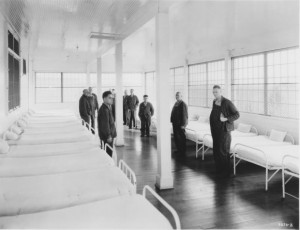When Dr. John Maurice Grimes inspected mental institutions in the U.S. (see last two posts), he discovered that the federal asylum in Washington, DC, (St. Elizabeths) was overcrowded.
It had a rated capacity of 3,700 patients and an actual patient population of 4,601 at the time of his visit. In contrast, the Canton Asylum for Insane Indians had a patient capacity of 92 and housed 89 patients.
Still, that lack of overcrowding could not make up for the asylum’s defects. “There is little about the place to commend it except the superintendent’s improvement program, which he is said to have been urging since before the entrance of America into the World War,” Grimes commented. He added, “The care of the insane among Indians and Alaskans is apparently a small task that has been almost forgotten . . . perhaps the mental hospital in the District of Columbia has been saved from a like neglect chiefly by its location.”
At the end of his study, Grimes made some rather biting comments about the country’s state of mental health care (through asylums):
— The average length of stay of a patient…is measured in years. A patient remaining in a hospital for such a period is not under medical treatment; he is not even under medical observation.
— The nurses and attendants are given little or no information regarding a patient. They know his name and perhaps his diagnosis.
— He [a patient] has been fed into the mill. Of all the grist on which the mill is grinding, he has an 11 percent chance to come out improved.
— 95 per cent of all patients ever discharged as recovered or improved are so discharged within two years.
It is chilling to think that if a patient could not make a positive enough impression on medical and attendant staff to get the attention and care needed to recover fairly quickly, he or she would be almost certainly doomed to years or a lifetime in a mental institution.








